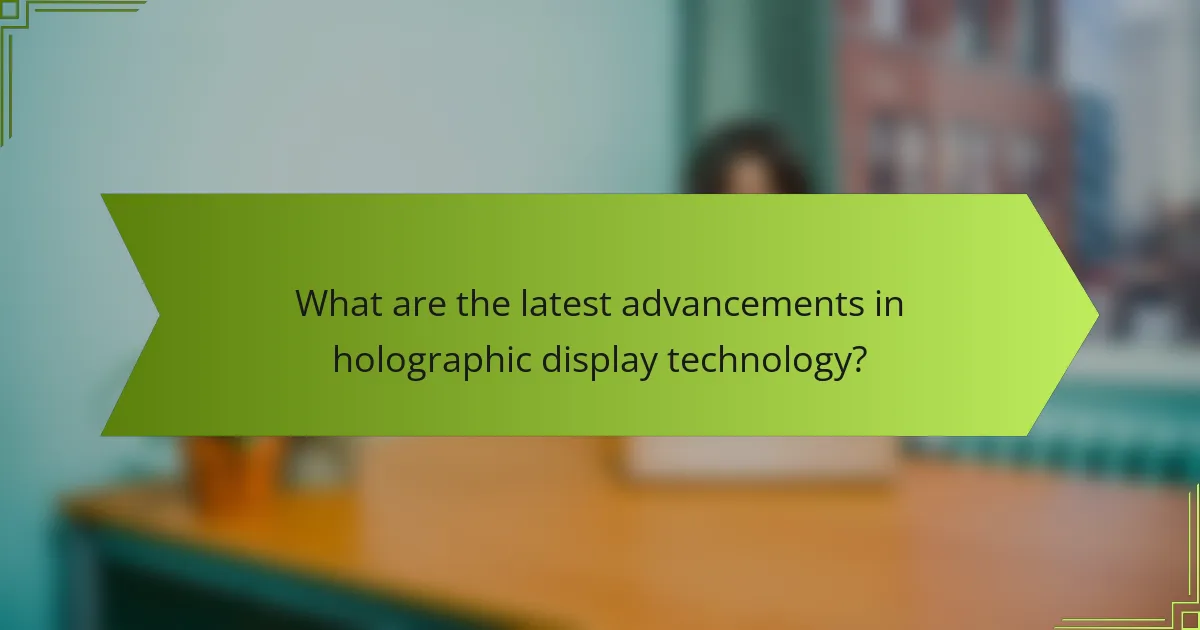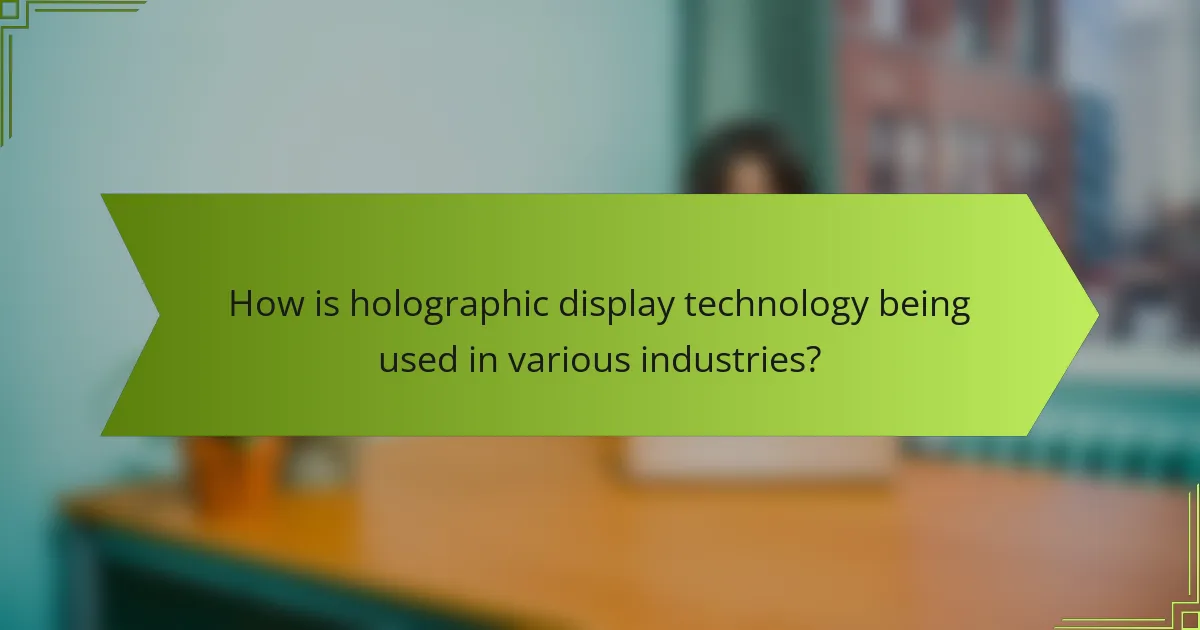Holographic display technology is rapidly evolving, with significant advancements in resolution, interactivity, and integration with augmented reality systems. As industries from healthcare to entertainment adopt these innovations, the technology is set to enhance user experiences and visualization capabilities. Looking ahead to 2024, trends such as increased accessibility and miniaturization promise to make holographic displays more practical and engaging for consumers and businesses alike.

What are the latest advancements in holographic display technology?
The latest advancements in holographic display technology include significant improvements in resolution, interactivity, and integration with augmented reality systems. These developments enhance user experiences across various applications, from entertainment to medical imaging.
Light Field Displays
Light field displays represent a major leap in holographic technology by allowing viewers to see images from different angles without the need for special glasses. This technology captures and reproduces light rays from multiple directions, creating a more immersive experience. Companies are exploring various applications, including gaming and virtual meetings, where realistic depth perception is crucial.
One notable consideration is the complexity of manufacturing light field displays, which can be cost-prohibitive. As production techniques improve, prices are expected to decrease, making this technology more accessible to consumers.
Augmented Reality Integration
Augmented reality (AR) integration with holographic displays is transforming how users interact with digital content. By overlaying holograms onto the real world, AR enhances user engagement in fields like education, training, and retail. For instance, retailers can use AR to allow customers to visualize products in their own space before making a purchase.
However, successful AR implementation requires robust hardware and software compatibility. Users should ensure that their devices meet the necessary specifications to fully utilize these advanced holographic features.
3D Projection Systems
3D projection systems are evolving to deliver more realistic holographic images by utilizing advanced optics and projection techniques. These systems can create lifelike representations of objects, making them ideal for exhibitions, presentations, and entertainment venues. The use of high-definition projectors combined with specialized screens enhances the clarity and depth of the projected images.
When considering 3D projection systems, it’s essential to evaluate the environment where they will be used. Factors such as ambient light and viewing distance can significantly affect the quality of the holographic display. Proper setup and calibration are crucial for achieving optimal results.

How is holographic display technology being used in various industries?
Holographic display technology is increasingly utilized across various industries to enhance visualization, improve user interaction, and provide immersive experiences. Its applications range from healthcare to entertainment, each leveraging the unique capabilities of holography to address specific needs.
Healthcare Applications
In healthcare, holographic displays are revolutionizing medical imaging and surgical planning. Surgeons can visualize complex anatomy in three dimensions, allowing for more precise operations and better patient outcomes. For instance, holograms can be generated from MRI or CT scans, enabling doctors to study the patient’s condition in detail before performing procedures.
Additionally, holographic displays are being used for patient education, helping individuals understand their medical conditions through interactive visualizations. This can lead to improved patient engagement and satisfaction.
Entertainment and Gaming
The entertainment and gaming industries are embracing holographic display technology to create immersive experiences that captivate audiences. Holograms can bring characters to life, allowing players to interact with them in a three-dimensional space, enhancing the overall gaming experience.
Live events, such as concerts and theatrical performances, are also utilizing holography to project performers and special effects, creating a unique atmosphere. This technology can attract larger audiences and offer a novel way to experience entertainment.
Education and Training
In education, holographic displays are transforming traditional learning methods by providing interactive and engaging content. Students can explore complex subjects, such as biology or physics, through three-dimensional models that enhance understanding and retention of information.
Training programs, especially in fields like aviation and military, are using holography to simulate real-world scenarios. This allows trainees to practice skills in a safe environment, improving their readiness for actual situations.

What are the key trends in holographic display technology for 2024?
In 2024, key trends in holographic display technology include increased accessibility, enhanced user interaction, and miniaturization of devices. These advancements are set to transform how consumers and businesses engage with digital content, making holographic displays more practical and user-friendly.
Increased Accessibility
As holographic display technology evolves, it is becoming more accessible to a broader audience. This includes reduced costs for production and improved availability of devices in consumer markets. Companies are focusing on creating affordable models that can be integrated into everyday devices, such as smartphones and tablets.
Additionally, software advancements are simplifying the user experience, allowing individuals without technical expertise to utilize holographic displays effectively. This trend is expected to democratize access to immersive experiences across various sectors, including education and entertainment.
Enhanced User Interaction
Enhanced user interaction is a significant trend, with holographic displays incorporating more intuitive control methods. Gesture recognition and voice commands are becoming standard features, allowing users to interact with holograms in a natural and immersive manner. This shift is particularly beneficial in fields like gaming and training simulations.
Moreover, the integration of augmented reality (AR) elements into holographic displays is fostering a more engaging experience. Users can manipulate holograms in real-time, leading to applications in design, healthcare, and remote collaboration that require high levels of interactivity.
Miniaturization of Devices
Miniaturization is another key trend, as manufacturers strive to create smaller, more portable holographic displays. Advances in materials and engineering are enabling the production of compact devices without compromising on quality. This trend is crucial for expanding the use of holographic technology in mobile applications.
For instance, wearable holographic displays are on the horizon, offering users a hands-free experience that integrates seamlessly into their daily lives. As these devices become more prevalent, they will likely open new avenues for personal and professional use, making holographic technology a staple in various industries.

What factors should businesses consider when adopting holographic displays?
Businesses should evaluate several key factors when adopting holographic displays, including cost, technical compatibility, and user experience design. These elements will significantly influence the successful integration and effectiveness of the technology in their operations.
Cost of Implementation
The cost of implementing holographic displays can vary widely based on the technology’s complexity and the scale of deployment. Initial investments may range from a few thousand to several hundred thousand dollars, depending on hardware, software, and installation needs.
Ongoing expenses, such as maintenance and updates, should also be factored into the budget. Businesses should consider potential return on investment (ROI) by evaluating how holographic displays can enhance customer engagement or operational efficiency.
Technical Compatibility
Ensuring technical compatibility with existing systems is crucial for a smooth transition to holographic displays. Businesses should assess whether their current hardware and software can support the new technology, including graphics processing capabilities and network infrastructure.
Additionally, it may be necessary to integrate holographic displays with other technologies, such as augmented reality (AR) or virtual reality (VR) systems. Conducting a thorough compatibility analysis can help prevent costly disruptions during implementation.
User Experience Design
User experience design plays a vital role in the effectiveness of holographic displays. Businesses must consider how users will interact with the technology and ensure that the interface is intuitive and engaging.
Testing with real users can provide valuable feedback on design elements, such as navigation and content presentation. Prioritizing user experience can lead to higher satisfaction and better adoption rates of holographic displays within the organization.

What are the challenges facing holographic display technology?
Holographic display technology faces several significant challenges that hinder its widespread adoption. Key issues include high production costs, limited content availability, and various technical limitations that affect performance and usability.
High Production Costs
The production costs of holographic displays remain a major barrier to entry for many manufacturers and consumers. Advanced materials and complex manufacturing processes contribute to expenses that can reach thousands of dollars per unit. As a result, these displays are often priced out of reach for average consumers and small businesses.
To mitigate costs, companies are exploring alternative manufacturing techniques and materials that could lower expenses. However, achieving a balance between affordability and quality remains a challenge.
Limited Content Availability
Another significant challenge is the limited availability of content specifically designed for holographic displays. Unlike traditional media, holographic content requires specialized creation tools and expertise, which are not yet widely accessible. This scarcity can deter potential users who seek engaging experiences.
To address this issue, partnerships between holographic display manufacturers and content creators are essential. Developing platforms that facilitate content creation and distribution can help expand the library of available holographic experiences.
Technical Limitations
Technical limitations also pose challenges to the effectiveness of holographic displays. Issues such as resolution, viewing angles, and refresh rates can affect the overall user experience. For instance, many current holographic displays struggle to maintain clarity at wider angles, which can limit their practical applications.
Ongoing research and development are focused on overcoming these technical hurdles. Innovations in optics and display technology may lead to improvements in performance, making holographic displays more viable for everyday use.

How does holographic display technology compare to traditional display technologies?
Holographic display technology offers a more immersive viewing experience compared to traditional display technologies like LCD and OLED. While traditional displays present images on a flat surface, holographic displays create three-dimensional images that can be viewed from multiple angles, enhancing depth perception and realism.
Image Quality Differences
Holographic displays typically provide superior image quality by presenting images with greater depth and clarity. Unlike traditional displays that rely on pixels, holographic technology utilizes light interference to create images, resulting in smoother gradients and more vibrant colors.
In practical terms, this means that holographic displays can render images that appear more lifelike, making them ideal for applications in fields such as medicine, education, and entertainment. For instance, a holographic medical model can allow doctors to visualize organs in 3D, improving understanding and precision during procedures.
However, the technology is still evolving, and current holographic displays may face challenges such as lower brightness levels and viewing angle limitations compared to high-end traditional displays. Users should consider these factors when choosing between holographic and conventional options.
